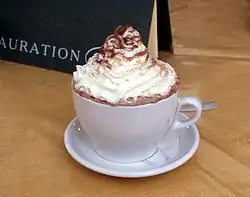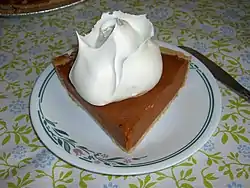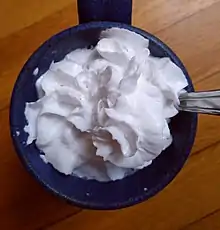Whipped cream
Whipped cream is liquid heavy cream that is whipped by a whisk or mixer until it is light and fluffy and holds its shape, or by the expansion of dissolved gas, forming a firm colloid. It is often sweetened, typically with white sugar, and sometimes flavored with vanilla. Whipped cream is also called Chantilly cream (or crème Chantilly; pronounced [kʁɛm ʃɑ̃tiji]).
 A cup of hot chocolate topped with whipped cream from a pressurized can | |
| Type | Cream |
|---|---|
| Main ingredients | Cream |
| Variations | Added sugar and other flavorings, such as vanilla |


Fat content
The cream used as whipping cream has a high butterfat content—typically 30%–36%—as fat globules contribute to forming stable air bubbles.[1]
During whipping, partially coalesced fat molecules create a stabilized network which traps air bubbles.[2] The resulting colloid is roughly double the volume of the original cream. If, however, the whipping is continued, the fat droplets will stick together destroying the colloid and forming butter. Lower-fat cream (or milk) does not whip well, while higher-fat cream produces a more stable foam.[3]
Methods of whipping
Cream is usually whipped with a whisk, an electric hand mixer, or a food processor. Results are best when the equipment and ingredients are cold.[4] The bubbles in the whipped cream immediately start to pop, and it begins to liquefy, giving it a useful lifetime of one to two hours. Many 19th-century recipes recommend adding gum tragacanth to stabilize whipped cream, while a few include whipped egg whites.[5] Various other substances, including gelatin and diphosphate, are used in commercial stabilizers.[6][7][8][9]
Instant
Whipped cream may also be made instantly in a aerosol can or in a whipping siphon with a whipped-cream charger. A gas dissolves in the butterfat under pressure. When the pressure is released, the gas leaves solution, producing bubbles. The gas is typically nitrous oxide, as carbon dioxide tends to give a sour taste.[10] Other names for cream sold in an aerosol can are skooshy cream (Scottish), squirty cream, spray cream,[11] or aerosol cream.[12][13] A common brand in the United States is Reddi-Wip. In some jurisdictions, sales of canned whipped cream are limited to avoid potentially dangerous nitrous oxide abuse.[14]
Flavorings
Whipped cream is often flavored with sugar, vanilla, coffee, chocolate, orange, and so on.[15]
History
Les mousses se font avec de la crême bien douce & peu épaisse; on la fouette, ce qui la fait mousser, & c'est de cette mousse qu'on fait usage: on peut lui donner tel goût que l'on veut, aromates, fleurs, fruits, vins, ou liqueurs.
Mousses are made with sweet cream, not very thick; one whips it, which makes it foam, and it is this foam that one uses: one may give it whatever flavor one wants, with aromatics, flours, fruits, wines, or liqueurs.
M. Emy, 1768[16]
Whipped cream, often sweetened and aromatised, was popular in the 16th century,[17] with recipes in the writings of Cristoforo di Messisbugo (Ferrara, 1549),[18] Bartolomeo Scappi (Rome, 1570),[17] and Lancelot de Casteau (Liège, 1604).[19] It was called milk or cream snow (neve di latte, neige de lait, neige de crème).[20] A 1545 English recipe, "A Dyschefull of Snow", includes whipped egg whites as well, and is flavored with rosewater and sugar (cf. snow cream).[21] In these recipes, and until the end of the 19th century, naturally separated cream is whipped, typically with willow or rush branches, and the resulting foam ("snow") on the surface would from time to time be skimmed off and drained, a process taking an hour or more. By the end of the 19th century, centrifuge-separated, high-fat cream made it much faster and easier to make whipped cream.[3]
The French name crème fouettée 'whipped cream' is attested in 1629,[22] and the English name "whipped cream" in 1673.[23] The name "snow cream" continued to be used in the 17th century.[24][25]
Various desserts consisting of whipped cream in pyramidal shapes with coffee, liqueurs, chocolate, fruits, and so on either in the mixture or poured on top were called crème en mousse 'cream in a foam', crème fouettée, crème mousseuse 'foamy cream', mousse 'foam',[16][26] and fromage à la Chantilly 'Chantilly-style molded cream', as early as 1768.[27][28][29] Modern mousses, including mousse au chocolat, are a continuation of this tradition.
Cream whipped in a whipping siphon with nitrous oxide was invented in the 1930s by both Charles Getz, working with G. Frederick Smith,[30][31] and Marshall Reinecke.[32] Both filed patents, which were later litigated. The Getz patents were originally deemed invalid, but were upheld on appeal.[10]
Crème Chantilly
Crème Chantilly is another name for whipped cream. The difference between "whipped cream" and "crème Chantilly" is not systematic. Some authors distinguish between the two, with crème Chantilly being sweetened, and whipped cream not.[33] However, most authors treat the two as synonyms,[34] with both being sweetened,[35][36] neither being sweetened,[5][37] or treating sweetening as optional.[38][39] Many authors use only one of the two names (for the sweetened or unsweetened version), so it is not clear whether they distinguish the two.[40]
The invention of crème Chantilly is often credited incorrectly, and without evidence, to François Vatel, maître d'hôtel at the Château de Chantilly in the mid-17th century.[41][42] But the name Chantilly is first connected with whipped cream in the mid-18th century,[43] around the time that the Baronne d'Oberkirch praised the "cream" served at a lunch at the Hameau de Chantilly—but did not say what exactly it was, or call it Chantilly cream.[44][45]
The names "crème Chantilly", "crème de Chantilly", "crème à la Chantilly", or "crème fouettée à la Chantilly" only become common in the 19th century. In 1806, the first edition of Viard's Cuisinier Impérial mentions neither "whipped" nor "Chantilly" cream,[46] but the 1820 edition mentions both.[47]
The name Chantilly was probably used because the château had become a symbol of refined food;[48] the word has since become a culinary shorthand for "cream".[49]
Imitation whipped cream

Imitations of whipped cream, often called whipped topping (formerly whip topping), are commercially available.[50] They may be used to avoid dairy ingredients, to provide extended shelf life, or to reduce the price (although some popular brands cost twice as much as whipped cream).[51]
The earliest known recipe for a non-dairy whipped cream was published by Ella Eaton Kellogg in 1904; consistent with her Seventh-day Adventist practices, it replaced cream with almond butter. Based on research sponsored by Henry Ford, a soy-based whip topping was commercialized by Delsoy Products by 1945. Delsoy did not survive, but Bob Rich's Rich Products frozen "Whip Topping", also introduced in 1945, succeeded. Rich Products topping was reformulated with coconut oil replacing soy oil in 1956.[50]
Artificial whipped topping normally contains some mixture of partially hydrogenated oil, sweeteners, water, and stabilizers and emulsifiers added to prevent syneresis. In regulatory contexts, this is called "whipped edible oil topping".[52]
It may be sold frozen in plastic tubs (e.g., Cool Whip), or in aerosol containers or in liquid form in cartons, reminiscent of real whipping cream.
Uses
Whipped cream is a popular topping for fruit and desserts such as pie, ice cream (especially sundaes), cupcakes, cakes, milkshakes, waffles, hot chocolate, cheesecakes, Jello and puddings. It is also served on coffee, especially in the Viennese coffee house tradition, where coffee with whipped cream is known as Melange mit Schlagobers. Whipped cream is used as an ingredient in many desserts, for example as a filling for profiteroles and layer cakes.[53]
It is often piped onto a dish using a pastry bag to create decorative shapes.
Mousse is usually based on whipped cream, often with added egg white foam. Similarly, crémet d'Anjou is made of whipped cream and whipped egg whites.[54] Fontainebleau and crémet d'Angers include whipped cream and whipped fromage frais, and are typically served in a cheese drainer (faisselle), recalling the former process of draining whipped cream.[55]
See also
- Alcohol-infused whipped cream
- Dream Whip – a powdered dessert topping mix
- Schlagobers – Richard Strauss' "Whipped Cream" ballet
References
- "Whipped Cream Structure | Food Science". www.uoguelph.ca. Retrieved 2020-01-04.
- Viet; Cua (2015). "Effect of thermal treatment on physical properties and stability of whipping and whipped cream". Journal of Food Engineering. 163: 32–36. doi:10.1016/j.jfoodeng.2015.04.026.
- Harold McGee, On Food and Cooking, 2007, ISBN 1416556370, p. 30–33
- Bilow, Rochelle (19 November 2014). "Whip it Real Good: How to Make Whipped Cream at Home". bonappetit.com.
- Émile Bernard Urbain Dubois, La Cuisine classique: études pratiques, raisonnées et démonstratives de l'Ecole française appliquée au service à la russe, 1868, p. 122: "La chantilly n'est autre chose que la crème double, amenée à consistance, et rendue mousseuse par le travail du fouet et l'action de l'air."
- Wayne Gisslen (2008). Professional Baking. p. 264. ISBN 978-0471783497.
- Alan Imeson, ed., Food Stabilisers, Thickeners and Gelling Agents, 2011, ISBN 1444360337, passim
- Rose Levy Beranbaum, The Pie and Pastry Bible, 2009, ISBN 1439130876, p. 550
- "Dr. Oetker Whip It". Dr. Oetker.
- Aeration Processes, Inc. v. Lange et al., 196 F.2d 981, 93 USPQ 332, United States Court of Appeals Eighth Circuit, May 20, 1952.
- https://www.tesco.com/groceries/en-GB/shop/fresh-food/milk-butter-and-eggs/fresh-cream-and-custard/squirty-cream
- "Category: Aerosol Cream". Staple Food Group. Retrieved 2020-11-21.
- Cooksinfo. "Aerosol Cream". CooksInfo. Retrieved 2020-11-21.
- "Want to buy canned whipped cream in New York state? Don't forget your ID". NBC News.
- Jules Gouffée et al., Le livre de pâtisserie, 1873 p. 138
- M. Emy (officier), L'Art de bien faire les glaces d'office... avec un traité sur les mousses, Paris, 1768 p. 222
- Terence Scully, trans., The Opera of Bartolomeo Scappi (1570): L'arte et prudenza d'un maestro Cuoco; The Art and Craft of a Master Cook, 2008, ISBN 0-8020-9624-7, p. 105, note 2.39, with many menus including "neve di latte servita con zuccaro sopra" 'milk snow with sugar on top', passim
- Michelle Berriedale-Johnson, Festive Feasts Cookbook (British Museum), 2004, ISBN 0-299-19510-4, p. 33, citing Messisbugo's Banchetti, composizioni di vivande e apparecchio generale
- Ouverture de cuisine, "Pour faire neige", p. 123 transcription
- Trésor de la langue française s.v. neige Étymologie B.2 (1552 quotation)
- Catherine Frances Frere, Prepere newe Booke of Cokerye, 1545 (modern edition 1913) -- cited in Scully
- Jean-Louis Guez de Balzac, Lettres de Phyllarque à Ariste full text
- "whipped". Oxford English Dictionary (Online ed.). Oxford University Press. (Subscription or participating institution membership required.)
- Dictionarium Rusticum, Urbanicum & Botanicum, 1726, s.v. 'Syllabub' full text
- Sarah Harrison, The house-keeper's pocket-book, and compleat family cook, 1749, p. 173. full text
- Alexandre-Balthazar-Laurent Grimod de La Reynière, Néo-Physiologie du gout par order alphabétique ou Dictionnaire générale de la cuisine française, 1839, p. 184
- Jim Chevallier, A History of the Food of Paris: From Roast Mammoth to Steak Frites, 2018, ISBN 1442272821, p. 195
- "Tante Marie", La Véritable cuisine de famille, comprenant 1.000 recettes et 500 menus, 18??, p. 296 "Crème fouettée (ou Fromage à la Chantilly)"
- Mrs. Beeton, The book of household management, 1888, p. 927
- Charles Getz, "Process of making aerated food products", U.S. Patent 2294172A, filed 26 September 1935, issued 25 August 1942 full text; also U.S. Patent 2435682 (continuation in part)
- "George Frederick Smith (1891-1976)". Chemistry at Illinois. University of Illinois. Archived from the original on 2013-11-04. Retrieved 2014-02-27.
- Marshall C. Reinecke, "Device for producing aerated expanded food products", U.S. Patent 2120297A, filed 15 August 1935, issued 14 June 1938 full text
- Robert J. Courtine, ed. (1974). "Crème fouettée et crème Chantilly". Curnonsky: Cuisine et Vins de France. Larousse. p. 535.
- "Crème fouettée, dite aussi crème Chantilly". Le Petit Robert. 1972.
- La Grande Encyclopédie (1902)
- Trésor de la langue française, s.v. crème
- Paul Bocuse, La cuisine du marché (1980), p. 414: "Crème Chantilly (crème fouettée)"
- La cuisine de Madame Saint-Ange (1927), p. 916f: "Crème fouettée dite « crème Chantilly »... Selon le cas, on ajoute du sucre en poudre, vanillé ou non, dans la crème fouettée."
- Julia Child et al., Mastering the Art of French Cooking, defines Crème Chantilly as "lightly beaten cream", then refers to it as "whipped cream". With added sugar or flavorings, she calls it "Flavored whipped cream" (I:580). In volume 2, one recipe for crème Chantilly is unsweetened (II:422), another is sweetened (II:450).
- Larousse du XIXe (1878) et le Littré (1872) mention only whipped (fouettée); le Larousse Gastronomique (1938) mentions only Chantilly
- Stephen Shapiro (2005). "Roland Joffé's Vatel". In Anne L. Birberick; Russell Ganim (eds.). Modern Perspectives on the Early Modern: Temps recherché, temps retrouvé. p. 84. ISBN 1-886365-54-7.
- "Histoire de la Crème Chantilly". Domaine de Chantilly. Archived from the original on 2013-04-16.
- Menon, ed. (1755). "Fromage à la chantilly glacé" [Ice cream whipped cheese]. Les soupers de la cour [Court suppers] (in French). pp. 313-314.
- "Jamais je n'ai mangé d'aussi bonne crème, aussi appétissante et aussi bien apprêtée". Mémoires de la baronne d'Oberkirch. Vol. 2. p. 112.
I have never eaten such good cream, so appetising and so well prepared
- "Naissance de la crème Chantilly". Tables princières à Chantilly, du XVIIe au XIXe siècle (in French). Archived from the original on 2011-06-13. Exposition du 16 septembre 2006 au 8 janvier 2007 — Tables princières à Chantilly, du XVIIe au XIXe siècle [Exhibition from September 16, 2006 to January 8, 2007 — Princely tables in Chantilly, from the 17th to the 19th century] (PDF) (in French). Musée Condé: Fondation pour la sauvegarde et le développement du domaine de Chantilly. Archived from the original (PDF) on 2008-11-15.
- Viard, A. (1806). Le cuisinier impérial, ou, L'art de faire la cuisine et la pâtisserie pour toutes les fortunes: avec différentes recettes d'office et de fruits confits, et la manière de servir une table depuis vingt jusqu'à soixante couverts. Barba – via Google Books.
- Viard, A.; Fouret (1820). Le cuisinier royal: ou l'Art de faire la cuisine, la patisserie et tout ce qui concerne l'office, pour toutes les fortunes. J.-N. Barba – via Internet Archive.
- Alan Davidson, The Oxford Companion to Food, s.v. 'cream'.
- Harry Louis Cracknell, G. Nobis, Practical Professional Gastronomy, 1985, ISBN 1349178764, p. 237
- William Shurtleff; Akiko Aoyagi (2013). History of Non-Dairy Whip Topping, Coffee Creamer. ISBN 978-1928914624.
- Patrick Di Justo (April 24, 2007). "Cool Whip". Wired.
- Code of Federal Regulations, Title 21, section 172.836 through 172.842
- Wayne Gisslen (2012). Professional Baking. p. 260. ISBN 978-1118254363.
- Manfred Höfler, Pierre Rézeau, Variétés géographiques du français: Matériaux pour le vocabulaire de l'art culinaire, 1997, ISBN 2252031530, p. 73
- J.P. Géné, "Fontainebleau, la crème du fromage", Le Monde April 27, 2016